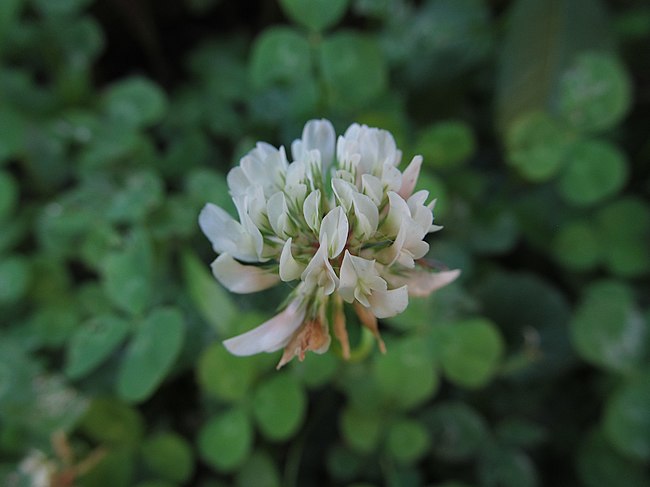
Ordinary white clover may be our most common lawn weed, beating even dandelions. It is an inoffensive weed, however, and it has its advantages. It is easy to mow; it has a pleasant sweet scent on a hot summer day; and bees love it. Up close, we can see that each tiny flower has all the parts of a sweet-pea flower, though on a much smaller scale. The leaflets often have a pale crescent marked near the base, and of course an occasional leaf grows with four leaflets.

Gray describes the genus and the species:
TRIFÒLIUM [Tourn.] L. CLOVER. TREFOIL. Calyx persistent, 5-cleft, the teeth usually bristle-form. Corolla mostly withering or persistent; the claws of all the petals, or of all except the oblong or ovate standard, more or less united below with the stamen-tube; keel short and obtuse. Tenth stamen more or less separate. Pods small and membranous, often included in the calyx, 1–6-seeded, indehiscent, or opening by one of the sutures. Tufted or diffuse herbs. Leaves mostly palmately (sometimes pinnately) 3-foliolate; leaflets usually toothed. Stipules united with the petiole. Flowers in heads or spikes. (Name from tres, three, and folium, a leaf.)
T rèpens L. (WHITE C.) Smooth perennial; the slender stems spreading and creeping; leaflets inversely heart-shaped or merely notched, obscurely toothed; stipules scale-like, narrow; petioles and especially the peduncles very long; heads small and loose; calyx much shorter than the white corolla; pods about 4-seeded.—Fields and copses, everywhere; indigenous only in the northern part of our range.


